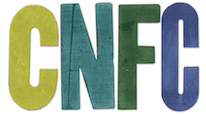Mandate
The CNFC Society exists to promote innovation in Canadian creative nonfiction writing. We strive for greater readership, to provide opportunities for our members to enrich their professional skills, to collaborate on new technologies and explore new approaches to publishing.
History of the CNFC
In 2004, our founders, Myrna Kostash and Betsy Warland, invited a group of writers to discuss the range and potential of this new growing literary genre. They debated the social, cultural and ethical issues that defined and preoccupied creative nonfiction writers in the early twenty-first century. This gathering, held in Banff, Alberta, became the first annual CNFC Conference. In April 2006, the group registered as a non-profit organization in the province of Alberta. In 2013, we revised our registration to incorporate as the Creative Nonfiction Collective Society, affectionately known to all of us as the CNFC. Since the founding of the CNFC, the genre of creative nonfiction has grown in prominence in traditional publishing and all other media. In the past decade, creative writing programs have appeared across the country, most recently the new Master of Fine Arts in Creative Nonfiction at University of King’s College in Halifax. Since the CNFC’s inception, we have also seen a noticeable increase in the number of literary contests, awards, and grants for creative nonfiction. Canada even has a literary festival dedicated to nonfiction: Edmonton’s annual Litfest. The CNFC has played a vital role in the continuing development and success of Canadian creative nonfiction. Recently the organization applied to obtain charitable status. The CNFC hopes to have achieved this status by 2021. Known as literary or narrative nonfiction, the genre of creative nonfiction is characterized as a personal, identifiable voice. The writer is usually quite present in the text. Works of creative nonfiction include – but are not limited to – memoirs, biography, historical investigation, literary journalism, political commentary, social or cultural criticism, and essays that are personal or lyric or narrative.
The emphasis in creative nonfiction is on the use of inventive and dramatic techniques when writing about the actual world rather than a fictional one. The adjective “creative” in creative nonfiction is occasionally misunderstood. Being creative in their work does not license nonfiction writers to invent facts or imagine experiences as fiction writers do. Creative nonfiction allows its writers rather to access the same techniques available to fiction writers without misrepresenting the actual events in their work. Debates about the distinctions between fiction and creative nonfiction are always lively. Even our own CNFC members don’t always agree on an exact definition of creative nonfiction. What most do agree on is the fact that the genre is becoming more and more popular in the literary and publishing communities, surpassing literary fiction and poetry among some big publishers such as HarperCollins, Random House, and others.
Evolution of the term “creative nonfiction”
In 2010, the CNFC conducted a survey of The Writers Union of Canada (TWUC). Of TWUC’s two thousand members, four hundred and forty-nine responded to the survey. Eighty percent of those responders identified themselves as creative non-fiction or non-fiction writers. The survey asked In the United States, as of 2009, the Library of Congress (which determines and assigns all subject headings) did not have Creative Non-Fiction as a genre term in its system. The closest terms (other than sub-genre terms) they used were reportage literature and belle letters.
Currently, most Canadian literary agents now consider Creative Non-Fiction the preferred name for a genre still not easily defined. Some use “Creative Nonfiction” as an umbrella term that encompasses “Literary Nonfiction” and “Narrative Nonfiction.”
In the awards arena, “Creative Nonfiction” and “Literary Nonfiction” both appear. Two national government-sponsored awards (Canada Council Grants, Governor General’s Award), and the national Charles Taylor Prize use Literary Nonfiction.
The CBC Literary Awards has a “Creative Nonfiction” category. Some provincial and city awards across Canada still use a generic “Nonfiction” category.
Most creative writing programs across Canada now use the term Creative Nonfiction.
Literary journals often hold Creative Nonfiction contests. Some refer to our genre as Literary Nonfiction or simply Nonfiction. Others will use other designations completely, such as features, essays, articles, or prose.
Responders to sequence their order of preference for names to call our genre of writing: creative non-fiction, literary non-fiction, non-fiction, belles lettres, narrative non-fiction, literary prose, or prose. “Creative Non-fiction” received the most support (31%), followed by “Literary Non-fiction” (22%). “Non-fiction” came in third (16%). “Belles Lettres” came in fourth (13%). “Narrative Non-fiction” ranked fifth (11%).
Since then, the hyphen in the word “non-fiction” has largely disappeared. The label “Creative Nonfiction” has become the most prominent, although both “Literary Nonfiction” and “Narrative Nonfiction” continue to appear.
Canadian publishers tend towards the term “Literary Nonfiction.” Some publishers don’t distinguish between “Creative Nonfiction” and other forms of nonfiction.
Bookstores seldom have a “Creative Nonfiction” section. Our works are scattered among a variety of nonfiction genres such as biography, travel, history, etc. This can make our diverse genre difficult to find.
